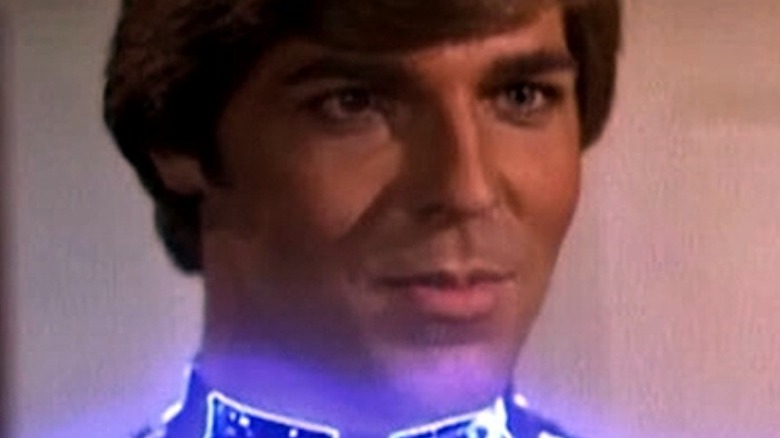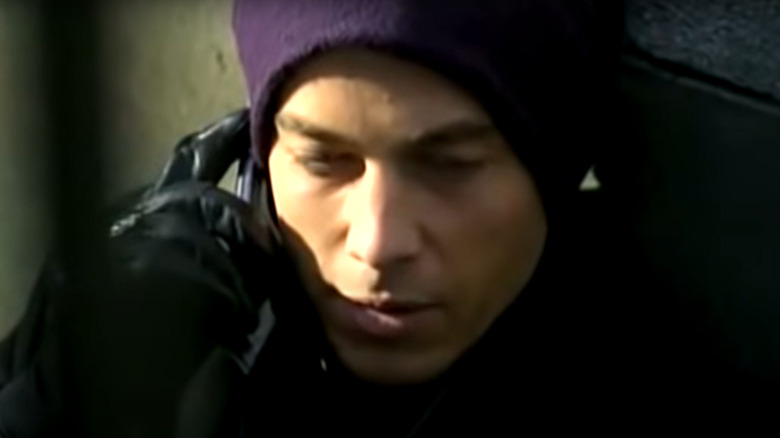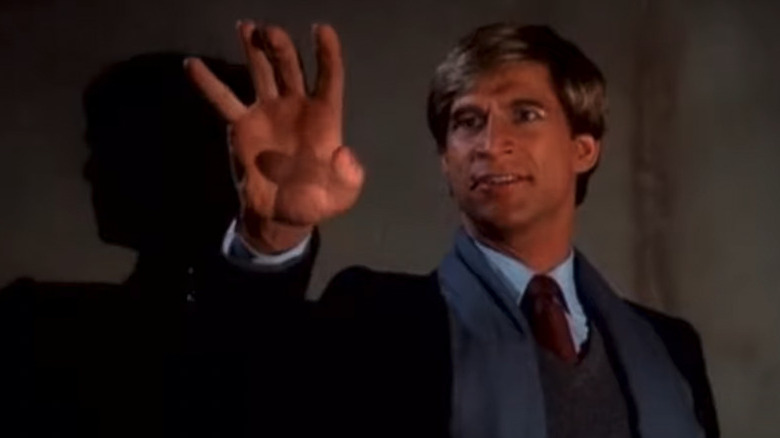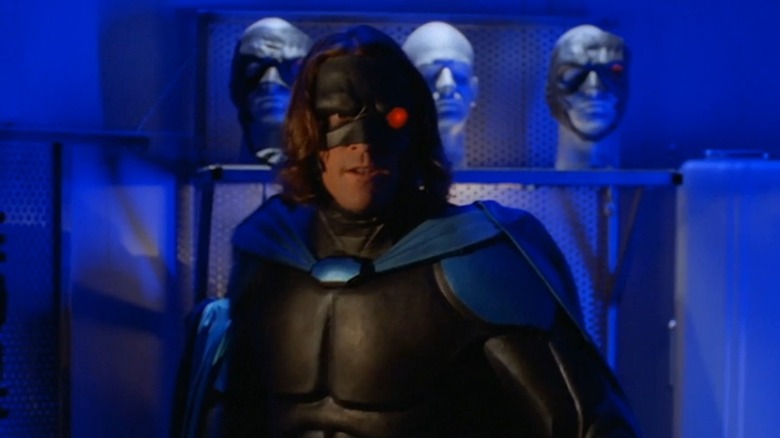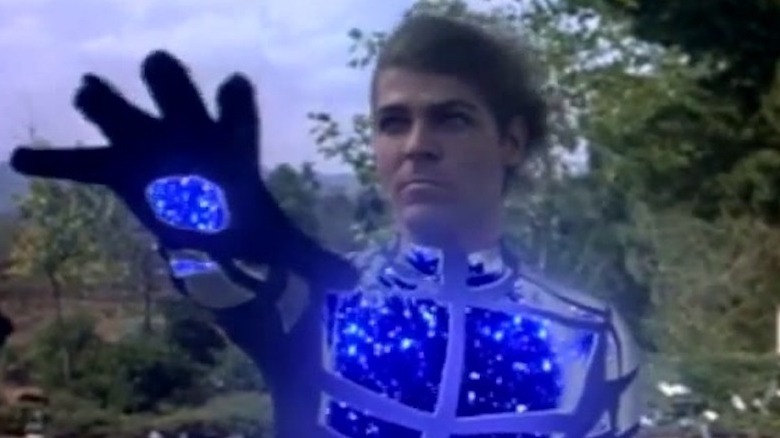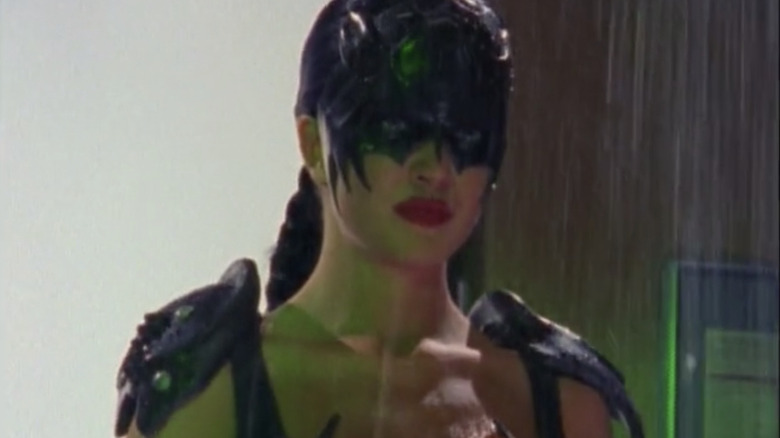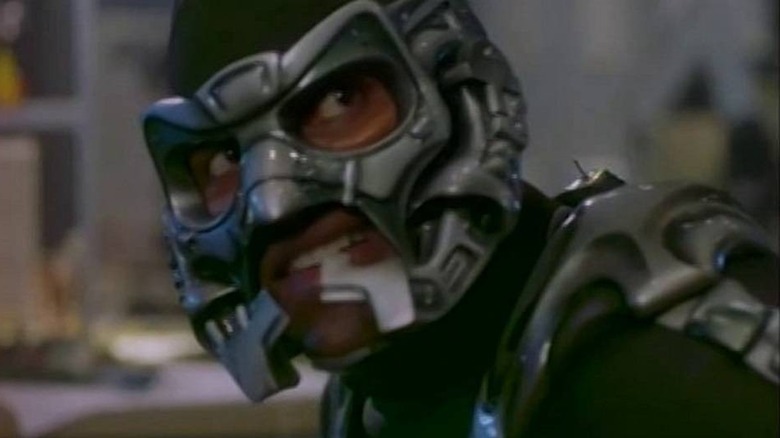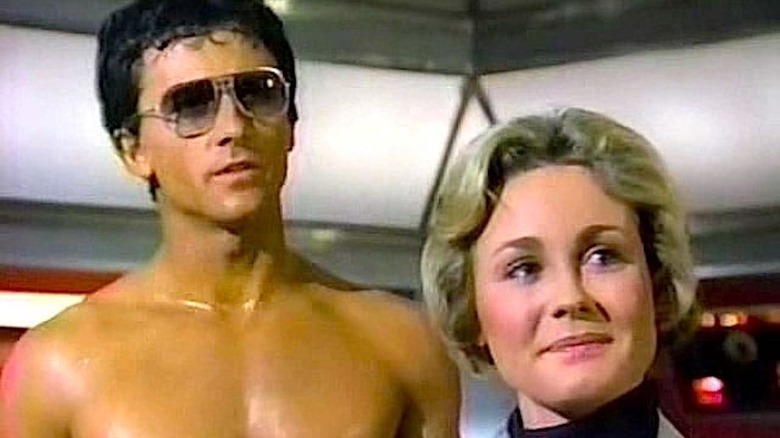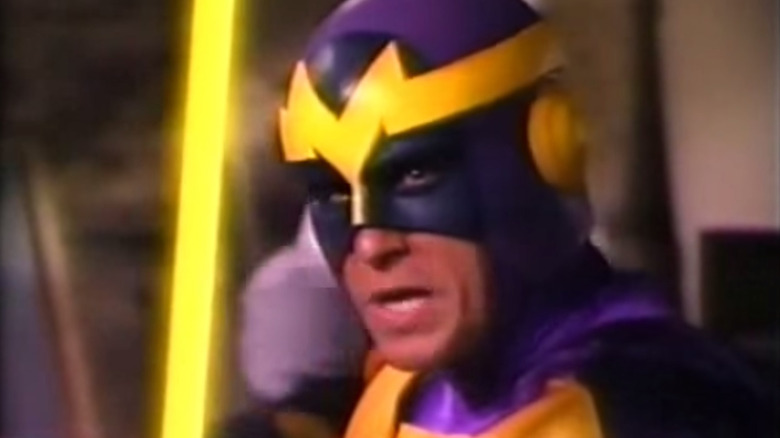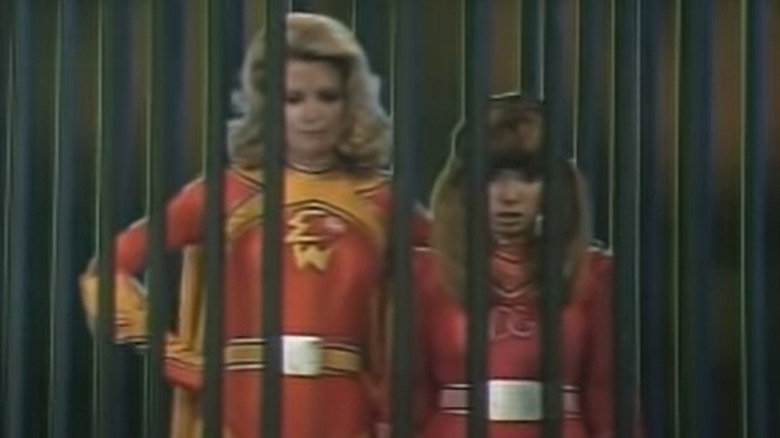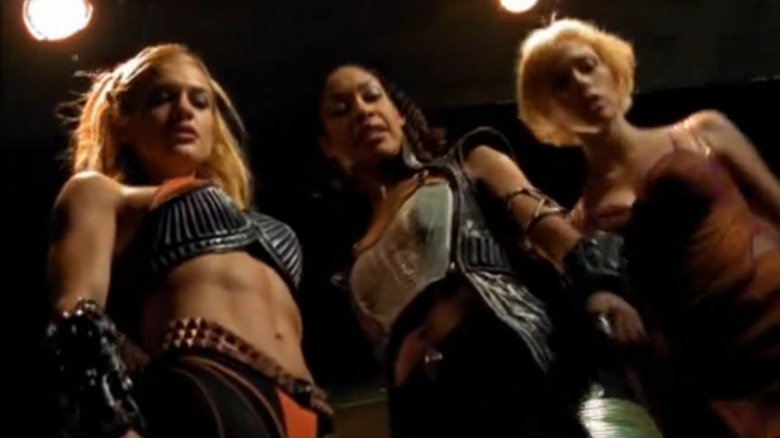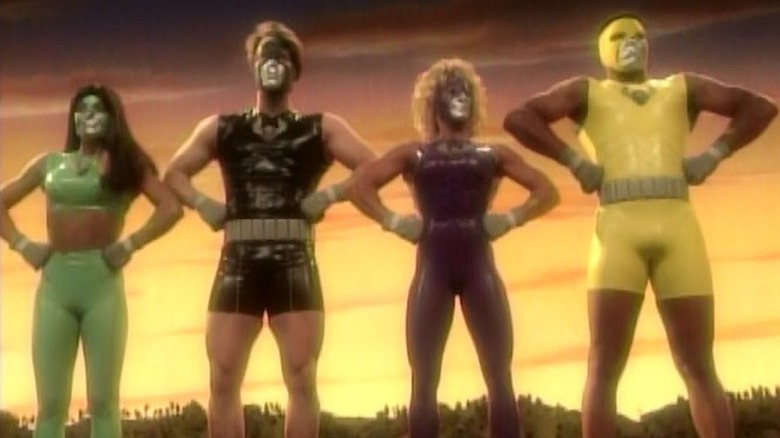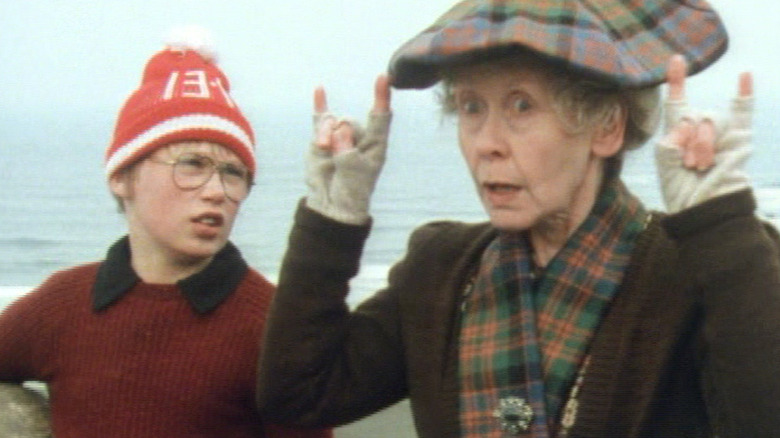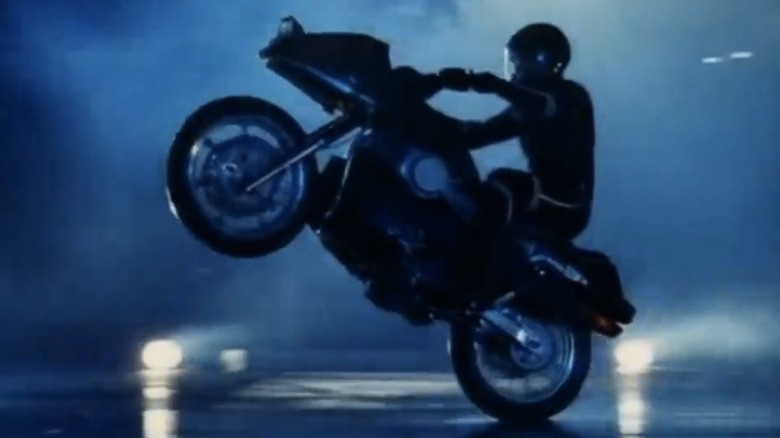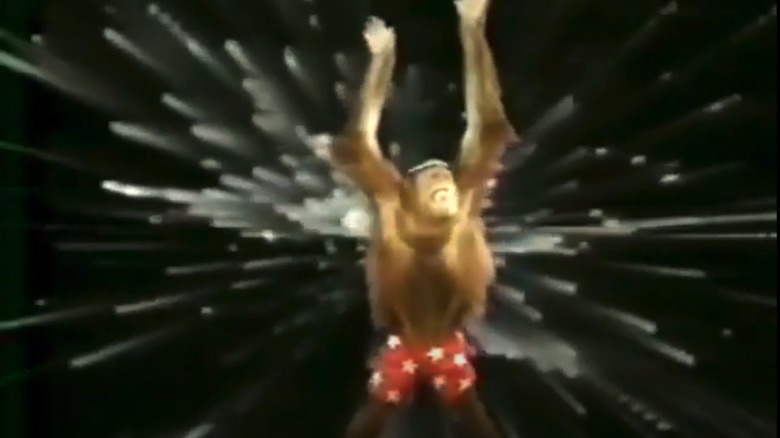The Worst And Weirdest Superhero TV Shows That Actually Existed
Television began adapting superheroes shortly after their emergence in the comics, most notably with the 1952 series "Adventures of Superman." Over the course of the following decades, icons of the ink and wood pulp world anchored wildly popular shows like "Wonder Woman," "Batman," "The Incredible Hulk," and "Lois & Clark: The New Adventures of Superman."
Today, superhero shows are one of TV's biggest genres. Streaming services like Netflix and Amazon are awash in big budget comics adaptations, while Disney+ has become home to a host of massively popular Marvel originals. While there are plenty of positive examples of superheroes in television to emphasize, they don't tell the whole story. In fact, superhero TV shows were more often misses than hits for quite some time, with numerous flops coming and going quickly. Some didn't succeed because of low quality; others were just too weird to find an audience at the time. And some had both problems.
While we tend to remember the more popular winners, we often gloss over the losers. But it would be a shame if these missteps were entirely forgotten, so we put together this list of the weirdest and worst superhero TV shows we could find.
The Phantom
Hollywood can't seem to let go of the Phantom. As one of the earliest comic strip superheroes debuting way back in 1936, the Phantom predates Superman, Batman, and the rest of the DC and Marvel rosters we've all come to know and love. He's been adapted into other mediums with varying degrees of success on several occasions, including a 1950s serial, the '80s cartoon "Defenders of the Earth," and his own oddly out-of-time cartoon "Phantom 2040" in 1994. He finally made it to the big screen in 1996, but the movie flopped hard. But bombing out of movies didn't stop the Phantom, even though it definitely should have. In 2009, a live action Phantom TV show debuted, and it's both incredibly weird and incredibly bad.
"The Phantom," airing on SyFy, starred soap opera actor Ryan Carnes as Chris Moore, a lawyer and parkour enthusiast. As you are certainly already aware, the phrase "parkour enthusiast" is usually an ominous sign when it appears in a television show synopsis. "The Phantom" is no exception to that rule. Chris learns he's actually the descendant of a centuries-old superhero, the Phantom, and takes up the mantle after his parents are killed. Unfortunately, the final product bares almost no resemblance to the character from the comics, which wasn't lost on reviewers who saw the trailer.
Thanks to its stilted performances and bad visuals, SyFy's "The Phantom" seems like it was assembled via a selection of random elements pulled from a drawer full of spare bad ideas. Thankfully, this one was limited to a two-part television miniseries. While there may have been some hope for a full run at one point, "The Phantom" was promptly put out to pasture.
Manimal
Perhaps one of the most infamous entries on this list, the 1983 science fiction superhero series "Manimal" is exactly what you'd expect from its wonderfully wacky title. The brainchild of "Battlestar Galactica" creator Glen A. Larson, the series might be most noteworthy for its special effects by award-winning FX guru Stan Winston. Beyond that, it's an oddity in every sense, from its cornball cast to its offbeat premise and tone.
The series centers on Jonathan Chase, a scientist who possesses a supernatural ability to shapeshift into various animals. Whether it's a hawk, a panther, a snake, or a bear, Chase morphs into a beast each episode to battle evil. He's aided by his confidante and companion Tyrone Earl and intrepid police detective Brooke McKenzie. In its eight-episode run, the Manimal battles all kinds of criminals: Russian terrorists, horse thieves, criminal syndicates, and naturally, diabolical poachers.
Over the years, "Manimal" has been mocked for its clunky storytelling but gained a cult following for its goofiness and unique mix of genre elements. Perhaps its swift cancellation had as much to do with the network's choice to air it in the same time slot as "Dallas," TV's biggest hit of the decade, as it did the not-inconsiderable failings of "Manimal" itself.
Night Man
From the late-'90s up to the early '00s, characters from smaller publishers like Malibu Comics and Image Comics felt just as likely to show up on TV as anyone from the more familiar DC and Marvel crews. While plenty of folks vaguely recall the "Witchblade" series on TNT, Sara Pezzini's short tenure on cable television isn't ridiculous enough to qualify for this list. "Night Man," however, is a different matter.
"Night Man" is based on the Malibu character of the same name, originally created by Steve Englehart, who is also credited with dreaming up Shang-Chi and Star-Lord. The series debuted in 1997 with prolific stuntman Matt McColm playing the title hero.
"Night Man" chronicles the exploits of jazz musician Johnny Domino, who gains the superhuman ability to literally see evil while losing the ability to sleep. He dons a rubber suit with a red bionic eye for some reason and sets out to fight crime, as one does. If that sounds even cheesier than "Manimal," maybe that's because "Battlestar Galactica" creator Glen A. Larson developed "Night Man" for TV, just as he once did for the animal transformation-oriented program from the previous decade.
The most memorable feature of "Night Man" is probably its guest appearances, including musical icon Little Richard and trashy talk show luminary Jerry Springer. Remarkably, "Night Man" got a second season, which gave audiences one of the most unexpected TV crossovers ever. In the sixth episode of Season 2, Simon MacCorkindale reprises his role as Jonathan Chase, aka, the Manimal, and Night Man meets one of Larson's other short-lived superheroes.
Automan
Prolific television producer Glen A. Larson shows up a few times on this list, which could leave a reader with misleading notions about his track record. He produced a few clunkers over the years, but he also scored massive hits including "Knight Rider," and "Magnum, P.I." One of his major misses was the 1983 superhero action series "Automan," memorable for its early use of computer-generated effects. Though the visuals actually look impressive by the standards of its era, the show was mostly attempting to ape the look and feel of Disney's revolutionary film "Tron" from a year earlier.
Like "Tron," the series' hero is a living digital program created by a computer engineer who also happens to be a police officer. Unlike the protagonist of "Tron," this program is designed to exit the virtual computer world and fight crime. While he's in the real world, the program known as Automan takes on the Earthly identity of Otto J. Mann. That's a pretty clever secret identity, right? Nobody's ever going to figure that one out. Merging with his programmer, they become one superhero being with a digital sidekick named ... Cursor. Yeesh.
An ambitious and high-concept sci-fi superhero series that failed to execute its lofty premise, "Automan" lasted a single season. It may not be the worst thing the '80s produced, but its corniness had few boundaries. In spite (or because?) of this corniness, "Automan" secured enough of a fanbase over the years to warrant a DVD release in 2015.
Black Scorpion
This 2001 Sci-Fi Channel superhero series has its origins in a low-budget 1995 film produced by legendary B-movie proprietor Roger Corman. The film version of "Black Scorpion" saw actress Joan Severance star as a police detective who becomes a scantily clad superhero by night. While the direct-to-video sequel failed to make waves at that year's Academy Awards, a series was commissioned with a new cast including Michelle Lintel as the new lead.
Just like the movies, the series follows Darcy Walker, a police detective who becomes frustrated with her limitations as an officer of the law. To get around them, she ditches the badge and puts on a leather bathing suit in order to fight crime with the freedom to beat up anyone she wants as mercilessly as she feels like with zero consequences.
With cheap production values, a weak cast, eye-rolling stories, and a remarkable willingness to temp DC's copyright lawyers with completely blatant and shameless Batman parroting, "Black Scorpion" is impossible to take seriously.
M.A.N.T.I.S.
Before actor Carl Lumbly became known for voicing J'onn J'onzz in the DC Animated Universe, he had a role as another TV superhero. In 1995, for one season, he starred as the eponymous crime-fighting hero in "M.A.N.T.I.S.," a series with a legendary pedigree. Created by the dynamic duo of director Sam Raimi and "Batman" screenwriter Sam Hamm, "M.A.N.T.I.S." also has a strong cast and a progressive concept well ahead of its time in the mid-'90s.
The show centers on Miles Hawkins, a wheelchair-bound scientist who fights a losing battle against a corrupt police force that has long targeted the Black community. Seeking to fight for justice, Miles builds himself a special exo-suit that allows him to hit the streets as a righteous vigilante powered by a Mechanically Augmented NeuroTransmitter Interactive System, aka M.A.N.T.I.S.
With a mostly Black cast — a rarity for sci-fi media of its day — and an innovative concept, "M.A.N.T.I.S." had a lot going for it on paper. Unfortunately, the show's potentially powerful superhero story leans into its goofiness and often feels designed to sell toys.
Man from Atlantis
Marvel has Namor the Sub-Mariner and DC Comics has Aquaman, but surely audiences can never forget television's first live action undersea superhero: the Man from Atlantis. Then again, maybe audiences can absolutely forget television's first live action undersea superhero. This disastrous television series came and went quickly, and not without good reason. Starring relative newcomer Patrick Duffy, just a year away from his career-defining role as Bobby Ewing on "Dallas," the series turns him into a bizarre hero who emerges from the ocean to fight crime.
Launching off a series of four successful TV movies in 1977, the weekly "Man from Atlantis" TV series only made it through its first season before its 1978 cancellation. The series focuses on a mysterious amnesiac who washes ashore one fateful day. A scientific curiosity, he wields superhuman strength to complement his webbed hands and gills. Nursed back to health by a cheery marine biologist, he soon takes the name of Mark Harris and goes to work for the government as a speedo-clad do-gooder.
Though not the worst show on this list, it's easily one of the weirdest ones despite its familiar concept. Even within the series' scant 13 episodes, storylines get bonkers enough to include Wild West doppelgangers, pirates, and a hypnotic mermaid.
Bibleman
Designed as low-budget religious philosophy show for kids, the evangelical Christian TV series "Bibleman" comes to us from actor Willie "Buddy" Aames of "Charles in Charge" fame and has produced episodes on a sporadic basis since 1995, with IMDb noting the most recent edition of "Bibleman" aired in 2010.
Laughably bad, the goofy costumes, ham-fisted churchy storytelling, and all-around awful production might make us think "Bibleman" was some kind of scam except we are unaware of any hard evidence that would support such an accusation. "Bibleman" is a series about Miles Peterson, a sinner who repents and becomes the scripture-thumping vigilante Bibleman. He quotes gospel as he battles evil-doers, because what else can be expected from a Bibleman?
Despite all odds, "Bibleman" has spawned a bona fide franchise that includes an animated series and the toys and merchandise that inevitably follow an animated series. But the original live action series is so infamously terrible, it prompted political satirist David Mitchell to remark, "You must think it's been made by anti-Christian people to make Christianity look as [bad] and discouraging and artless as possible."
Electra Woman and Dyna Girl
Just six months after Lynda Carter debuted as Diana Prince in 1975's "Wonder Woman" on ABC, a similar series landed on TV — this time with a duo of superhero ladies aimed at a child audience.
Created by Sid and Marty Krofft, "Electra Woman and Dyna Girl," initially consisted of 12-minute episodes starring Deirdre Hall and Judy Strangis as the title heroines. Though partly a parody pastiche of crime-fighting comic superheroes, it's actually worth watching as a relic of the psychedelic 1970s. The two heroes have plenty of Electra-fied accessories and gadgets, like an Electra-car and an Electra-computer, kind of like Batman. The original series produced 16 episodes featuring low-rent villains, silly stories, and laughable hijinks that are fun as long as you're in on the joke.
Some 25 years later, Warner Bros. tried to revive "Electra Woman and Dyna Girl" with a reboot series starring Markie Post, but the pilot episode never aired.
Cleopatra 2525
Based on the success of "Xena: Warrior Princess," a few of the show's producers took a swing at another action program helmed by combat-savvy women punching evildoers in far-off, fantastical environs. But if you think "Cleopatra 2525" is a series about an ancient Egyptian queen transported into the future, think again. Instead, the series is about an exotic dancer from the modern era fighting tyranny in the 26th century.
When her life is imperiled by a botched breast augmentation surgery, protagonist Cleo enters a state of cryogenic stasis. Awakened in the year 2525, she joins two other women warriors in their battle against a malignant empire of giant flying robots. Humans of the future reside in an underground society run the so-called Shaft Builders who have constructed a series of elaborate subterranean tunnels.
Somehow "Cleopatra 2525" got a second season, though it ended on an unresolved cliffhanger. Considering the prominence of a boob job in its main character's origin story, it's safe to surmise "Cleopatra 2525" isn't as progressive as it thinks it is, and clearly can't hold a candle to "Xena: Warrior Princess" in any respect. However, "Cleopatra 2525" is the show Gina Torres was on directly before she became Zoë Washburne on "Firefly." Therefore, "Cleopatra 2525" warrants a brief but honorable footnote in the big book of sci-fi TV history.
Tattooed Teenage Alien Fighters from Beverly Hills
An obvious Xerox of "Mighty Morphin Power Rangers" with a little bit of "Saved by the Bell" mixed in for good measure, "Tattooed Teenage Alien Fighters from Beverly Hills" combines teen melodrama and Japanese rubber-suited monster fights, quite like multiple other programs its production company DIC Entertainment was associated with in the '90s.
The story centers on a group of teens who are chosen by a pulsating alien crystal creature to defend the Earth with newly granted superpowers and dynamic alter-egos. As the Earth is apparently the nexus for a set of "power portals" that an intergalactic tyrant wants to control, only our heroes can stand in his way. It's all pretty standard stuff for this kind of show, yet somehow it all feels even worse than its contemporaries. SyFy Wire went so far as to compare "TTAFFBH" to director Tommy Wiseau's infamous magnum opus, "The Room."
"TTAFFBH" took a unique approach to a tried-and-true formula by replacing the charming heroes of "Power Rangers" with a cast of obnoxious, unlikable, arrogant high schoolers who all seem to hate each other. While that sounds like a pretty great premise for a modern satirical comedy, it doesn't work at all for a '90s Saturday morning kids' show.
Super Gran
The U.K. has a mighty legacy when it comes to sci-fi on TV, producing globally recognized pop culture staples like "Doctor Who" and "The Prisoner," in addition to cult series like "Red Dwarf." But you still wouldn't expect anybody from any country to pull off a show about a grandmother with superpowers. And yet, here we are discussing the 1985 family comedy "Super Gran," which has gone on to become a beloved classic ... of sorts.
The series stars Gudrun Ure as the title character, an aging retiree with superpowers. The little old Scottish woman lives a quiet life in England until she's struck by a beam from a scientist's incredible invention, granting her kryptonian-like abilities. From enhanced hearing to super-speed and the ability to jump great distances, there's seemingly nothing she can't do. With her powers, she fights crime in her small English community.
Popular with kids, "Super Gran" even won an Emmy, and was exported to more than 60 countries worldwide. It's certainly not one of the worst, but it's definitely one of the weirdest superhero TV shows of all time.
Street Hawk
The 1980s was a decade of action shows with iconic vehicles — there's the van from "The A-Team," KITT from "Knight Rider," and the helicopter from "Airwolf." But the TV gods didn't forget about motorcycles, and that's where the short-lived "Street Hawk" comes in. The terribly contrived adventure series follows Jesse Mach, a police liaison and biker who is recruited by a shadowy government agency to fight crime.
Played by the eventual answer to the trivia question "Who played Daredevil on TV before Charlie Cox?" Rex Smith, Jesse takes the superhero vigilante nickname Street Hawk and is bestowed a superpowered top-secret motorcycle. Capable of incredible speeds and packed with the most awesome firepower you can afford to show off in a low-budget TV series, Jesse leads a secret double life. But despite his bike's powers, his secret identity, and clandestine government backing, Street Hawk is oddly relegated to battling with ordinary car thieves, burglars, and blackmailers.
Though it's received some retro reviews that give it high marks, we're betting it's a case of '80s nostalgia and rose-colored glasses. "Street Hawk" only lasted 14 episodes, and clips found online do anything but impress.
Going Bananas
The 1984 superhero sitcom "Going Bananas" is a series that looks like it was going to be a disaster right from the start. Unlike "Super Gran," this one never became a classic. In fact, watching clips of this monstrosity makes one wonder how it ever made it to air. Surely, if everyone involved was a sane, reasonably intelligent person, then at least one person on the production team, crew, or in the studio would have raised their hand and asked what the heck made anyone think putting this show out was a good idea.
Produced by Hanna-Barbera, "Going Bananas" is about a zoo animal named Roxana Banana who escapes her enclosure and is promptly struck by a ray from a passing spaceship, granting her superpowers. Does the spaceship ever pop up again over the course of the show? Do we ever find out why aliens gave a monkey superpowers? We do not. But Roxana nevertheless finds herself pursued by crooks who want to take advantage of her abilities. Meanwhile, she's sheltered by an ordinary family and gets caught up in plenty of wacky capers and bumbling hijinks. NBC found success with basically the same premise a few years later with "ALF," but until then they had to slog it out for 12 episodes of "Going Bananas."
Remarkably, the series' main human character Hank was played by none other than James Avery, aka Uncle Phil from "The Fresh Prince of Bel Air."
